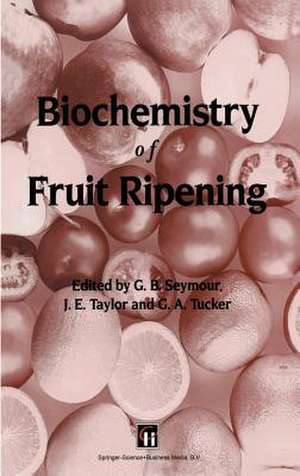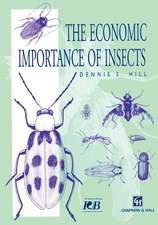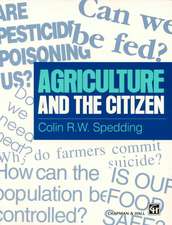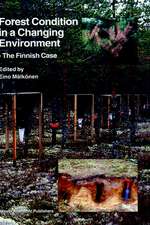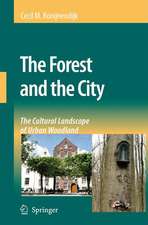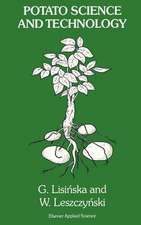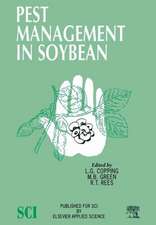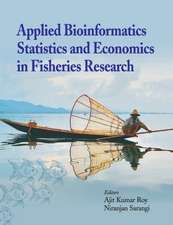Biochemistry of Fruit Ripening
Editat de G.B. Seymour, J. E. Taylor, Gregory A. Tuckeren Limba Engleză Hardback – 30 apr 1993
| Toate formatele și edițiile | Preț | Express |
|---|---|---|
| Paperback (1) | 2095.66 lei 6-8 săpt. | |
| SPRINGER NETHERLANDS – 23 oct 2012 | 2095.66 lei 6-8 săpt. | |
| Hardback (1) | 1830.34 lei 6-8 săpt. | |
| SPRINGER NETHERLANDS – 30 apr 1993 | 1830.34 lei 6-8 săpt. |
Preț: 1830.34 lei
Preț vechi: 2232.12 lei
-18% Nou
Puncte Express: 2746
Preț estimativ în valută:
350.28€ • 380.35$ • 294.23£
350.28€ • 380.35$ • 294.23£
Carte tipărită la comandă
Livrare economică 23 aprilie-07 mai
Preluare comenzi: 021 569.72.76
Specificații
ISBN-13: 9780412408304
ISBN-10: 0412408309
Pagini: 454
Ilustrații: XI, 454 p.
Dimensiuni: 155 x 235 x 25 mm
Greutate: 0.84 kg
Ediția:1993
Editura: SPRINGER NETHERLANDS
Colecția Springer
Locul publicării:Dordrecht, Netherlands
ISBN-10: 0412408309
Pagini: 454
Ilustrații: XI, 454 p.
Dimensiuni: 155 x 235 x 25 mm
Greutate: 0.84 kg
Ediția:1993
Editura: SPRINGER NETHERLANDS
Colecția Springer
Locul publicării:Dordrecht, Netherlands
Public țintă
ResearchCuprins
1 Introduction.- 1.1 Respiration and energy.- 1.2 Flavour changes.- 1.3 Colour changes.- 1.4 Texture changes.- 1.5 Control of ripening.- 1.6 Conclusions.- References.- 2 Avocado.- 2.1 Introduction.- 2.2 Physiology.- 2.3 Biochemistry.- 2.4 Gene expression during fruit ripening.- References.- 3 Banana.- 3.1 Introduction.- 3.2 Ethylene production and respiration.- 3.3 Carbohydrate metabolism.- 3.4 Pigment changes.- 3.5 Cell wall changes.- 3.6 Phenolic compounds.- 3.7 Organic acid and amino acid metabolism.- 3.8 Production of volatile compounds.- 3.9 Lipids.- 3.10 Other changes.- 3.11 Concluding remarks.- References.- 4 Citrus fruit.- 4.1 Commercial importance of citrus fruit.- 4.2 Taxonomy and cultivars.- 4.3 Harvest.- 4.4 Postharvest.- 4.5 General physiology.- 4.6 Biochemical changes during development, ripening and storage.- 4.7 Citrus biotechnology.- References.- 5 Exotics.- 5.1 Introduction.- 5.2 Persimmon.- 5.3 Lychee.- 5.4 Guava.- 5.5 Annona species.- 5.6 Carambola.- 5.7 Tamarillo.-5.8 Passion fruit.- 5.9 Mangosteen.- 5.10 Feijoa.- 5.11 Rambutan.- References.- 6 Grape.- 6.1 Origin and distribution.- 6.2 Grape berry morphology.- 6.3 Fruit growth and development.- 6.4 Growth regulation - phytohormones.- 6.5 Postharvest physiology.- 6.6 Handling and storage.- 6.7 Compositional changes.- 6.8 Phenolic compounds.- 6.9 Aroma.- 6.10 Cell wall metabolism.- References.- 7 Kiwifruit.- 7.1 Introduction.- 7.2 Physiology.- 7.3 Biochemistry.- 7.4 Pathways and enzymes.- 7.5 Regulation of ripening.- 7.6 Future prospects.- References.- 8 Mango.- 8.1 Introduction.- 8.2 Fruit development and harvest maturity.- 8.3 Ripening processes.- References.- 9 Melon.- 9.1 Introduction.- 9.2 Botany.- 9.3 Physiological changes during development and ripening.- 9.4 Biochemical changes during development and ripening.- 9.5 Postharvest diseases and disorders.- 9.6 Genetic improvement.- References.- 10 Pineapple and papaya.- 10.1 The pineapple — an introduction.- 10.2 Pineapple — physiology and biochemistry.- 10.3 Papaya — an introduction.- 10.4 Papaya — physiology.- 10.5 Papaya — biochemistry.- References.- 11 Pome fruits.- 11.1 Introduction.- 11.2 Physiology.- 11.3 Biochemistry.- 11.4 Regulation.- References.- 12 Soft fruit.- 12.1 Introduction.- 12.2 Physiology.- 12.3 Biochemistry.- 12.4 Metabolic pathways.- 12.5 Hormonal regulation of development and ripening.- 12.6 Gene expression during development and ripening.- References.- 13 Stone fruit.- 13.1 Introduction.- 13.2 The Prunus species and their origins.- 13.3 Peaches and nectarines (P. persica).- 13.4 Plum (P. domestica).- 13.5 Mume, or Japanese apricot (P. mume).- 13.6 Apricot (P. armeniaca).- 13.7 Almond (P. amygdalus).- 13.8 Tart or sour cherry (P. cerasus).- 13.9 Sweet cherry (P. avium).- 13.10 Olive (Olea europaea L).- References.- 14 Tomato.- 14.1 Introduction.- 14.2 History and classification.- 14.3 Tomato production.- 14.4 Fruit quality.- 14.5 Ethylene synthesis and action.- 14.6 Temperature stresses and their effects on ripening.- 14.7 The mechanism of tomato ripening.- 14.8 Non-ripening mutants.- 14.9 Cloning and characterization ripening-related mRNAs.- 14.10 Polygalacturonase and its role in texture change.- 14.11 Tomato genetic engineering.- 14.12 Control of fruit-specific and ripening-specific gene expression.- References.- Glossary of botanical names.
Recenzii
... the Biochemistry of Fruit Ripening is aimed at all those involved in planning, harvesting, transport and storage of fruit.... to emphasise in particular the advances made in the last 20 years. - Comment; ...400 well documented pages...In summary, this book should allow a researcher or teacher unfamiliar with this area to assemble biochemical information concerning a wide range of individual fruits efficiently - Plant Science
